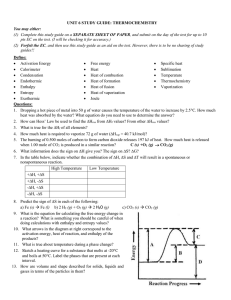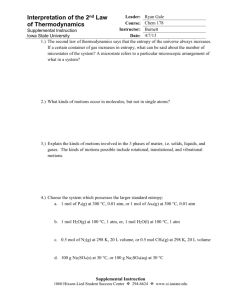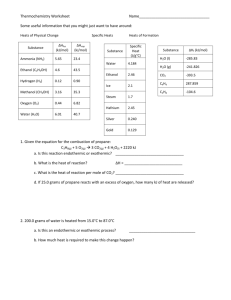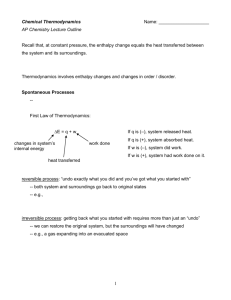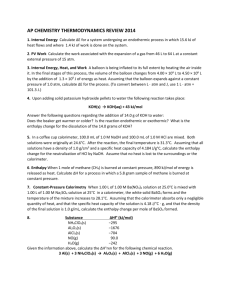S - PHA Science
advertisement
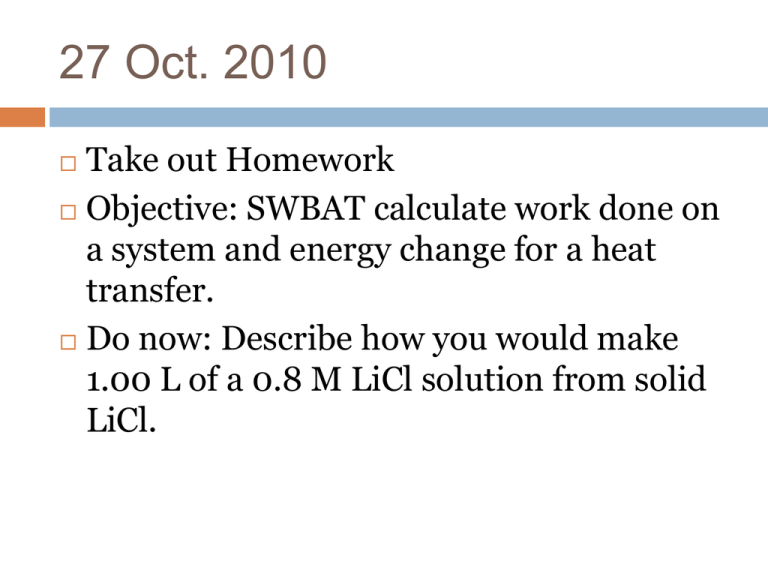
27 Oct. 2010 Take out Homework Objective: SWBAT calculate work done on a system and energy change for a heat transfer. Do now: Describe how you would make 1.00 L of a 0.8 M LiCl solution from solid LiCl. Agenda Do now II. Homework answers III. Thermochemistry notes and examples Part 1 Homework: p. 263 #13, 15, 17, 19 (ELS) Read p. 239-245 I. Thermochemistry Thermodynamics: study of interconversion of heat and other kinds of energy First Law of Thermodynamics: energy can be converted from one form to another, but can not be created or destroyed We can not accurately measure total energy of a system Instead, we measure changes in energy ΔE ΔEsys + ΔEsurr = 0 ΔEsys=- ΔEsurr energy gained in one place must be lost somewhere else In chem, we are usually interested in just the ΔE to the system we are studying: ΔE=q+w q=heat exchange between systems w=work done on or by the system Sign Conventions: heat and work Process Heat absorbed by the system (endothermic) Heat absorbed by the surroundings (exothermic) Work done by the system on surroundings Work done on the system by the surroundings Sign +q -q -w +w Exothermic process (-q) is any process that gives off heat – transfers thermal energy from the system to the surroundings. 2H2 (g) + O2 (g) H2O (g) 2H2O (l) + energy H2O (l) + energy Endothermic process (+q) is any process in which heat has to be supplied to the system from the surroundings. energy + 2HgO (s) energy + H2O (s) 2Hg (l) + O2 (g) H2O (l) Work, Pressure, and Volume w PV Expansion +V (increase) Compression -V (decrease) +w results -w results E system decreases Work has been done by the system on the surroundings E system increases Work has been done on the system by the surroundings Ex 1 A gas expands in volume from 2.0 L to 6.0 L at a constant temperature. Calculate the work done by the gas if it expands a) against a vacuum b) against a constant pressure of 1.2 atm 1 L·atm = 101.3 J Joule = unit of heat Ex 2 A gas expands from 264 mL to 971 mL at constant temperature. Calculate the work done (in J) by the gas if it expands a) against a vacuum b) against a constant pressure of 4.00 atm Ex 3 The work done when gas is compressed in a cylinder is 462 J. During this process, there is a heat transfer of 128 J from the gas to the surroundings. Determine the signs for q and w. Calculate the energy change for this process. ΔE=q+w Homework p. 263 #13, 15, 17, 19 (ELS) Read p. 239-245 28 Oct. 2010 Objective: SWBAT calculate heat change to a system given a thermochemical equation. Do now: The work done when gas is compressed in a cylinder is 462 J. During this process, there is a heat transfer of 128 J from the gas to the surroundings. Determine the signs for q and w. Calculate the energy change for this process. ΔE=q+w Agenda Do now II. Homework check III. Thermochemistry part 2 Homework: p. 263 #24, 25, 27 (JMS) Read p. 245-252, read lab handout and do pre-lab questions I. A gas expands and does P-V work on the surroundings equal to 279 J. At the same time, it absorbs 216 J of heat from the surroundings. What is the change in energy of the system? Enthalpy of Chemical Reactions Enthalpy (H) is used to quantify the heat flow into or out of a system in a process that occurs at constant pressure. H = E + PV H = H (products) – H (reactants) H = heat given off or absorbed during a reaction at constant pressure Hproducts < Hreactants H < 0 Hproducts > Hreactants H > 0 6.4 Thermochemical Equations Is H negative or positive? System absorbs heat Endothermic H > 0 6.01 kJ are absorbed for every 1 mole of ice that melts at 00C and 1 atm. H2O (s) H2O (l) H = 6.01 kJ Thermochemical Equations Is H negative or positive? System gives off heat Exothermic H < 0 890.4 kJ are released for every 1 mole of methane that is combusted at 250C and 1 atm. CH4 (g) + 2O2 (g) CO2 (g) + 2H2O (l) H = -890.4 kJ Thermochemical Equations • The stoichiometric coefficients always refer to the number of moles of a substance H2O (s) H2O (l) H = 6.01 kJ/mol ΔH = 6.01 kJ • If you reverse a reaction, the sign of H changes H2O (l) H2O (s) H = -6.01 kJ • If you multiply both sides of the equation by a factor n, then H must change by the same factor n. 2H2O (s) 2H2O (l) H = 2 mol x 6.01 kJ/mol = 12.0 kJ The physical states of all reactants and products must be specified in thermochemical equations. Example 1 Given the thermochemical equation 2SO2(g) + O2(g) 2SO3(g) H 198.2kJ/mol calculate the heat evolved when 87.9 g of SO2 is converted to SO3. Example 2 Calculate the heat evolved with 266 g of white phosphorus (P4) burns in air: P4(s) + 5O2(g) P4O10(s) H 3013kJ/mol Homework p. 263 #24, 25, 26 Read LAB, DO prelab, read in book…. 1 Nov. 2010 Take out pre-lab questions Objective: SWBAT calculate the amount of heat supplied to the surroundings (q) by a reusable chemical hand warmer. Do now: For the chemical hand warmer, predict the sign convention for heat (q) and work (w). Lab With your partner, carefully follow the directions. Hand warmer pouch and metal disk: 3.42 grams 2. Collect all data, results and answers to questions in your lab notebook. 3. Lab notebooks collected tomorrow: 2 lab grades. 1. 2 Nov. 2010 Objective: SWBAT relate ΔE to ΔH and complete calorimetric calculations. Do now: Type your second trial results into the spreadsheet. Homework: Lab notebooks due tomorrow – 2 lab grades p. 263 #27, 28, 31, 32, 34, 36 (JR) Comparing ΔH and ΔE ΔE = ΔH – RTΔn R = 8.314J/K·mol T = temperature in Kelvin n = number of moles For gas reactions, the change in volume can be very large because hot gases expand. For reactions not involving gas, ΔH and ΔE are often very similar. Ex 1 Calculate the change in internal energy when 2 moles of CO are converted to 2 moles of CO2 at 1 atm and 25oC 2CO(g) + O2(g) 2CO2(g) ΔH = -566.0 kJ/mol Ex 2 What is ΔE for the formation of 1 mole of CO at 1 atm and 25oC? C(graphite) + ½O2(g) CO(g) ΔH = -110.5 kJ/mol Calorimetry the measurement of heat changes q=CΔt C = heat capacity of a substance: the amount of heat required to raise the temperature of a given quantity of a substance by 1 degree Celsius. (=m*s) q=msΔt Ex. 1: A 466 g sample of water is heated from 8.50oC to 74.60oC. Calculate the amount of heat absorbed (in kJ) by the water. Ex. 2 1.435 grams of naphthalene (C10H8) was burned in a constant-volume bomb calorimeter. The temperature of the water rose from 20.28oC to 25.95oC. If the heat capacity of the bomb plus water was 10.17 kJ/oC, calculate the heat of combustion of naphthalene on a molar basis (find the molar heat of combustion). Ex. 3 A lead pellet having a mass of 26.47 g at 89.98oC was placed in a constant pressure calorimeter of negligible heat capacity containing 100.0 mL of water. The water temperature rose from 22.50oC to 23.17oC. What is the specific heat of the lead pellet? Homework Lab notebooks due tomorrow – 2 lab grades p. 263 #27, 28, 31, 32, 34, 36 (JR) 3 Nov. 2010 Take out Homework and Lab notebook Objective: SWBAT calculate the standard enthalpy of formation and reaction for compounds. Do now: An iron bar of mass 869 g cools from 94oC to 5oC. Calculate the heat released (in kJ) by the metal. specific heat of iron=0.444 J/g·oC Agenda Do now II. Homework check III. Standard Enthalpy of Formation/Reaction notes/problems Homework: p. 264 #42, 43, 46, 51, 53, 58, 63 (SR) Read p. 258-261: Heats of solution/dilution Tomorrow: Practice problems/review Bring your book to class! Test Monday (ch. 6) I. Announcement Tutor needed for 10th grade chem student. You will earn community service hours. Interested? See Ms. Kern. Standard Enthalpy of Formation and Reaction 0) is the Standard enthalpy of formation (H f heat change that results when one mole of a compound is formed from its elements at a pressure of 1 atm. The standard enthalpy of formation of any element in its most stable form is zero. Hf0 (O2) = 0 Hf0 (O3) = 142 kJ/mol Hf0 (C, graphite) = 0 Hf0 (C, diamond) = 1.90 kJ/mol 0 ) is the enthalpy The standard enthalpy of reaction (Hrxn of a reaction carried out at 1 atm. aA + bB cC + dD 0 Hrxn = [cH0f (C) + dH0f (D) ] - [aH0f (A) + bH0f (B) ] 0 Hrxn = SH0 f(products) - SH0f (reactants) Hess’s Law: When reactants are converted to products, the change in enthalpy is the same whether the reaction takes place in one step or in a series of steps. (Enthalpy is a state function. It doesn’t matter how you get there, only where you start and end.) Benzene (C6H6) burns in air to produce carbon dioxide and liquid water. How much heat is released per mole of benzene combusted? The standard enthalpy of formation of benzene is 49.04 kJ/mol. 2C6H6 (l) + 15O2 (g) 12CO2 (g) + 6H2O (l) Benzene (C6H6) burns in air to produce carbon dioxide and liquid water. How much heat is released per mole of benzene combusted? The standard enthalpy of formation of benzene is 49.04 kJ/mol. 2C6H6 (l) + 15O2 (g) 12CO2 (g) + 6H2O (l) H0 = S H0 (products) rxn f - S H0 (reactants) f H0 = [ 12H0 (CO2) + 6H0 (H2O)] - [ 2H0 (C6H6)] rxn f f f H0 = [ 12 × -393.5 + 6 × -285.8 ] – [ 2 × 49.04 ] = -6535 kJ rxn -6535 kJ = - 3267 kJ/mol C6H6 2 mol Practice Problem Calculate the heat of combustion for the following reaction: C2H4(g) + 3O2(g) 2CO2(g) + 2H2O(l) The standard enthalpy of formation of ethylene (C2H4) is 52.3 kJ/mol. Then, calculate per mole of ethylene combusted. What if the reaction is not a single step? Calculate the standard enthalpy of formation of CS2 (l) given that: 0 = -393.5 kJ C(graphite) + O2 (g) CO2 (g) H rxn S(rhombic) + O2 (g) SO2 (g) H rxn0 = -296.1 kJ CS2(l) + 3O2 (g) CO2 (g) + 2SO2 (g) 0 = -1072 kJ H rxn Calculate the standard enthalpy of formation of CS2 (l) given that: C(graphite) + O2 (g) CO2 (g) rxnH0 = -393.5 kJ 0 H rxn = -296.1 kJ 0 = -1072 kJ CS2(l) + 3O2 (g) CO2 (g) + 2SO2 (g) Hrxn 1. Write the enthalpy of formation reaction for CS2 S(rhombic) + O2 (g) SO2 (g) 2. Add the given rxns so that the result is the desired rxn. Calculate the standard enthalpy of formation of CS2 (l) given that: C(graphite) + O2 (g) S(rhombic) + O2 (g) CS2(l) + 3O2 (g) H0 = -393.5rxn kJ CO2 (g) H0 = -296.1rxn kJ SO2 (g) CO2 (g) + 2SO2 (g) H0 = -1072 kJ rxn 1. Write the enthalpy of formation reaction for CS2 C(graphite) + 2S(rhombic) CS2 (l) 2. Add the given rxns so that the result is the desired rxn. C(graphite) + O2 (g) CO2 (g) 2S(rhombic) + 2O2 (g) + CO2(g) + 2SO2 (g) H0 = -393.5rxn kJ 2SO2 (g) H0 = -296.1x2rxn kJ CS2 (l) + 3O2 (g) C(graphite) + 2S(rhombic) H0 = +1072 kJ rxn CS2 (l) H0 = -393.5 + (2x-296.1) + 1072 = 86.3 kJ rxn Calculate the standard enthalpy of formation of acetylene (C2H2) from its elements: 2C(graphite) + H2(g) C2H2(g) Here are the equations for each step: C(graphite) + O2(g) CO2(g) H0=-393.5 kJ/mol H2(g) + 1/2O2(g) H2O(l) H0=-285.8 kJ/mol 2C2H2(g) + 5O2(g) 4CO2(g) + 2H2O(l) H0= -2598.8 kJ/mol Homework p. 264 #42, 43, 46, 51, 53, 58, 63 Bring your book to class! 4 Nov. 2010 Take out homework: p. 264 #42, 43, 46, 51, 53, 58, 63 Objective: SWBAT review thermochemistry for a test on Monday! Do now: Calculate the standard enthalpy of formation of acetylene (C2H2) from its elements: 2C(graphite) + H2(g) C2H2(g) Here are the equations for each step: C(graphite) + O2(g) CO2(g) H0=-393.5 kJ/mol H2(g) + 1/2O2(g) H2O(l) H0=-285.8 kJ/mol 2C2H2(g) + 5O2(g) 4CO2(g) + 2H2O(l) H0= -2598.8 kJ/mol Agenda Do now II. Homework III. Chapter 6 Problem Set Work Time Homework: Finish problem set: Mon. Test: Mon. Bonus: Tues. I. Chapter 6 Problem Set Due Mon. p. 263 #16, 20, 33, 37, 38, 52, 54b, 57, 64, 70, 73, 80 Please show all your work! BONUS: p. 269 #119 Tues. (Up to +5% on your quarter grade!) Read p. 258-261: Heats of solution and dilution, on your own 8 Nov. 2010 Hand in Ch. 6 Problem Set Objective: SWBAT show what you know about thermochemistry on a test! Do Now: Review the sign conventions for q and w. A reaction absorbs heat from its surroundings and has work done on it by the surroundings. Is it endothermic or exothermic? What are the signs for q and w? Agenda Collect ch. 6 problem set II. Questions? III. Thermodynamics Test Homework: Bonus problem due tomorrow! p. 269 #119 Read p. 801-814 p. 829#1-5 I. 9 Nov. 2010 Take out homework: Bonus problem Objective: SWBAT predict and calculate entropy changes to systems. Do now: Give one example of a spontaneous process. Is it spontaneous in the opposite direction? Agenda Do now II. Notes on spontaneous processes and entropy III. Practice Problems Homework: p. 829 # 10-14 (SR) I. Thermodynamics Part 2 1st Law of Thermodynamics: energy can be converted from one form to another, but can not be created or destroyed. How to measure these changes? ∆H: Change in enthalpy: amount of heat given off or absorbed by a system 2nd Law of Thermodynamics: explains why chemical processes tend to favor one direction Spontaneous Processes Chemists need to be able to predict whether or not a reaction will occur when reactants are brought together under a specific set of conditions (temperature, pressure, concentration, etc.) Spontaneous Physical and Chemical Processes • A waterfall runs downhill • A lump of sugar dissolves in a cup of coffee • At 1 atm, water freezes below 0 0C and ice melts above 0 0C • Heat flows from a hotter object to a colder object • A gas expands in an evacuated bulb spontaneous • Iron exposed to oxygen and water forms rust nonspontaneous •Processes that occur spontaneously in one direction can not, under the same conditions, also take place spontaneously in the opposite direction! spontaneous nonspontaneous Does a decrease in enthalpy mean a reaction proceeds spontaneously? Spontaneous reactions CH4 (g) + 2O2 (g) H+ (aq) + OH- (aq) H2O (s) CO2 (g) + 2H2O (l) ∆H0 = -890.4 kJ/mol H2O (l) ∆H0 = -56.2 kJ/mol H2O (l) ∆H0 = 6.01 kJ/mol NH4NO3 (s) H2O NH4+(aq) + NO3- (aq) ∆H0 = 25 kJ/mol Does a decrease in enthalpy mean a reaction proceeds spontaneously? No! Being exothermic (“exothermicity”) favors spontaneity, but does not guarantee it! An endothermic reaction can be spontaneous. Not all exothermic reactions are spontaneous. So how do we predict if a reaction is spontaneous under given conditions if ∆H doesn't help us?! Entropy (S) is a measure of the randomness or disorder of a system. order S disorder S If the change from initial to final results in an increase in randomness, ∆S > 0 For any substance, the solid state is more ordered than the liquid state and the liquid state is more ordered than gas state Ssolid < Sliquid << Sgas H2O (s) H2O (l) ∆S > 0 Processes that lead to an increase in entropy (∆S > 0) 65 Example: Br2(l) ∆S > 0 Br2(g) Example: I2(s) ∆S > 0 I2(g) Entropy State functions are properties that are determined by the state of the system, regardless of how that condition was achieved. Examples: energy, enthalpy, pressure, volume, temperature, entropy Review Potential energy of hiker 1 and hiker 2 is the same even though they took different paths. 68 How does the entropy of a system change for each of the following processes? (a) Condensing water vapor (b) Forming sucrose crystals from a supersaturated solution (c) Heating hydrogen gas from 600C to 800C (d) Subliming dry ice How does the entropy of a system change for each of the following processes? (a) Condensing water vapor Randomness decreases Entropy decreases (∆S < 0) (b) Forming sucrose crystals from a supersaturated solution Randomness decreases Entropy decreases (∆S < 0) (c) Heating hydrogen gas from 600C to 800C Randomness increases Entropy increases (∆S > 0) (d) Subliming dry ice Randomness increases Entropy increases (∆S > 0) Practice Predict whether the entropy change is greater or less than zero for each of the following processes: a. freezing ethanol b. evaporating a beaker of liquid bromine at room temperature c. dissolving glucose in water d. cooling nitrogen gas from 80oC to 20oC First Law of Thermodynamics Energy can be converted from one form to another but energy cannot be created or destroyed. Second Law of Thermodynamics The entropy of the universe increases in a spontaneous process and remains unchanged in an equilibrium process. Spontaneous process: ∆Suniv = ∆Ssys + ∆Ssurr > 0 Equilibrium process: ∆Suniv = ∆Ssys + ∆Ssurr = 0 Entropy Changes in the System (∆Ssys) The standard entropy of reaction (∆S0rxn) is the entropy change for a reaction carried out at 1 atm and 250C. aA + bB cC + dD ∆S0rxn= [ cS0(C) + dS0(D) ] - [ aS0(A) + bS0(B) ] ∆S0 = Σ nS0(products) - Σ mS0(reactants) rxn What is the standard entropy change for the following reaction at 250C? 2CO (g) + O2 (g) 2CO2 (g) S0(CO) = 197.9 J/K•mol S0(O2) = 205.0 J/K•mol S0(CO2) = 213.6 J/K•mol Entropy Changes in the System (∆Ssys) The standard entropy of reaction (∆S0rxn) is the entropy change for a reaction carried out at 1 atm and 250C. aA + bB ∆S0rxn= cC + dD [ cS0(C) + dS0(D) ] - [ aS0(A) + bS0(B) ] ∆S0 = Σ nS0(products) - Σ mS0(reactants) rxn What is the standard entropy change for the following reaction at 250C? 2CO (g) + O2 (g) 2CO2 (g) S0(CO) = 197.9 J/K•mol S0(O2) = 205.0 J/K•mol S0(CO2) = 213.6 J/K•mol DS0 = 2 x S0(CO2) – [2 x S0(CO) + S0 (O2)] rxn DS0 = 427.2 – [395.8 + 205.0] = -173.6 J/K•mol rxn Practice From the standard entropy values in Appendix 3, calculate the standard entropy changes for the following reactions at 25oC: a. CaCO3(s) CaO(s) + CO2(g) b. N2(g) + 3H2(g) 2NH3(g) c. H2(g) + Cl2(g) 2HCl(g) Entropy Changes in the System (∆Ssys) When gases are produced (or consumed) • If a reaction produces more gas molecules than it consumes, ∆S0 > 0. • If the total number of gas molecules diminishes, ∆S0 < 0. • If there is no net change in the total number of gas molecules, then ∆S0 may be positive or negative BUT ∆S0 will be a small number. What is the sign of the entropy change for the following reaction? 2Zn (s) + O2 (g) 2ZnO (s) The total number of gas molecules goes down, ∆S is negative. Practice Predict (not calculate) whether the entropy change of the system in each of the following reactions is positive or negative: a. 2H2(g) + O2(g) 2H2O(l) b. NH4Cl(s) NH3(g) + HCl(g) c. H2(g) + Br2(g) 2HBr(g) d. I2(s) 2I(g) e. 2Zn(s) + O2(g) 2ZnO(s) Homework p. 829 # 10-14 (SR) 10 Nov. 2010 Objective: SWBAT calculate Gibbs free energy and predict the spontaneity of a reaction. Do now: Give one example of a change that increases entropy. Agenda Do now II. Homework: SR III. Gibbs Free Energy and Predicting Spontaneity HW: p. 829 #15, 16, 17, 18, 19, 20 (TTL) (Tues.) Read lab and answer pre-lab questions in lab notebook (Mon.) AP Test Thermo questions (Tues.) I. Entropy Changes in the Surroundings (∆Ssurr) Exothermic Process ∆Ssurr > 0 Endothermic Process ∆Ssurr < 0 Third Law of Thermodynamics The entropy of a perfect crystalline substance is zero at the absolute zero of temperature. S = k ln W W=1 S=0 82 Gibbs Free Energy Spontaneous process: ∆Suniv = ∆Ssys + ∆Ssurr > 0 Equilibrium process: ∆Suniv = ∆Ssys + ∆Ssurr = 0 For a constant-temperature process: Gibbs free energy (G) ∆G = ∆Hsys -T ∆Ssys ∆G < 0 The reaction is spontaneous in the forward direction. ∆G > 0 The reaction is nonspontaneous as written. The reaction is spontaneous in the reverse direction. ∆G = 0 The reaction is at equilibrium. The standard free-energy of reaction (∆G0rxn) is the free-energy change for a reaction when it occurs under standard-state conditions. aA + bB cC + dD ∆G0 (A) + b ∆G0 (B) ] ∆G0 = [c ∆G0 (C) +d ∆G0 (D) ] - a [ rxn f f f f ∆G0 = S n ∆G0 (products)- S m ∆G0 (reactants) rxn f f Standard free energy of formation (∆G0f ) is the freeenergy change that occurs when 1 mole of the compound is formed from its elements in their standard states. ∆G0 of any element in its stable form is zero. f What is the standard free-energy change for the following reaction at 25 0C? 2C6H6 (l) + 15O2 (g) 12CO2 (g) + 6H2O (l) What is the standard free-energy change for the following reaction at 25 0C? 2C6H6 (l) + 15O2 (g) 12CO2 (g) + 6H2O (l) DG0 = S nDG0 (products)- S mDG0 (reactants) rxn f f DG0 = [12DG0 (CO2) +6DG0 (H2O)] - [2DG0 (C6H6)] rxn f f f DG0 = [ 12x–394.4 + 6x–237.2 ] – [ 2x124.5 ] = -6405 kJ/mol rxn Is the reaction spontaneous at 25 0C? DG0 = -6405 kJ/mol< 0 spontaneous Practice Calculate the standard free-energy changes for the following reactions at 25oC a. CH4(g) + 2O2(g) CO2(g) + 2H2O(l) b. 2MgO(s) 2Mg(s) + O2(g) c. H2(g) + Br2(l) 2HBr(g) ∆G = ∆H - T ∆S Recap: Signs of Thermodynamic Values Negative Enthalpy (ΔH) Exothermic Positive Endothermic Entropy (ΔS) Less disorder More disorder Gibbs Free Energy (ΔG) Spontaneous Not spontaneous Homework p. 829 #15, 16, 17, 18, 19, 20 (TTL) (Tues.) Read lab and answer pre-lab questions in lab notebook (Mon.) AP Test Thermo questions (Tues.) 16 Nov. 2010 Objective: SWBAT calculate the temperature at which a reaction is spontaneous and review entropy and free energy problems. Do now: If enthalpy is positive and entropy is positive, at what temperatures will a reaction proceed spontaneously? Agenda Do now II. Homework solutions (TTL) III. AP Test question solutions - collected IV. Thermochemistry review problems Homework: Lab notebook: Thurs. Come after school to mass your filter paper + M2CO3! I. CaCO3(s) CaO(s) + CO2(g) CaO (quicklime) is used in steelmaking, producing calcium metal, paper making, water treatment and pollution control. It is made by decomposing limestone (CaCO3) in a kiln at high temperature. But, the reaction is reversible! CaO(s) readily combines with CO2 to form CaCO3. So, in the kiln, CO2 is constantly removed to shift equilibrium to favor the formation of CaO. At what temperature does this reaction favor the formation of CaO? Calculate ∆Ho and ∆So for the reaction at 25oC. Then plug in to ∆Go=∆Ho – T∆So to find ∆Go What sign is ∆Go? What magnitude? Set ∆Go=0 to find the temperature at which equilibrium occurs. At what temperature can we expect this reaction to proceed spontaneously? Choose a temperature, plug in and check. Keep in mind that this does not mean that CaO is only formed above 835oC. Some CaO and CO2 will be formed, but the pressure of CO2 will be less than 1 atm (its standard state). Practice Problems 1. Find the temperatures at which reactions will the following ∆H and ∆S will be spontaneous at 25oC: a. ∆H = -126 kJ/mol ∆S = 84 J/K·mol b. ∆H = -11.7 kJ/mol ∆S = -105 J/K·mol Solutions to AP test problems Thermochemistry review p. 831 #42, 52, 54, 56, 57, 60, 78 Quiz Thursday Entropy (S) Free energy (G) Study homework assignments from chapter 18, AP test questions, these review problems. stop During the course of a chemical reaction, not all the reactants and products will be at their standard states (1.0 atm and 25oC). How do you calculate free energy (and thus, the spontaneity of the reaction)? Gibbs Free Energy and Chemical Equilibrium ∆G = ∆ G0 + RT lnQ R is the gas constant (8.314 J/K•mol) T is the absolute temperature (K) Q is the reaction quotient At Equilibrium ∆G = 0 Q=K 0 = ∆G0 + RT lnK ∆G0 = - RT lnK What is Q? Reaction quotient What is K? equilibrium constant ∆G0 = - RT lnK 18.6 The specific heat (s) [most books use lower case c] of a substance is the amount of heat (q) required to raise the temperature of one gram of the substance by one degree Celsius. The heat capacity (C) of a substance is the amount of heat (q) required to raise the temperature of a given quantity (m) of the substance by one degree Celsius. C = ms Heat (q) absorbed or released: q = mst q = Ct t = tfinal - tinitial 6.5 Phase Changes The boiling point is the temperature at which the (equilibrium) vapor pressure of a liquid is equal to the external pressure. The normal boiling point is the temperature at which a liquid boils when the external pressure is 1 atm. 11.8 The critical temperature (Tc) is the temperature above which the gas cannot be made to liquefy, no matter how great the applied pressure. The critical pressure (Pc) is the minimum pressure that must be applied to bring about liquefaction at the critical temperature. 11.8 Can you find… Where’s Waldo? The Triple Point? Critical pressure? Critical temperature? Where fusion occurs? Where vaporization occurs? Melting point (at 1 atm)? Boiling point (at 6 atm)? Carbon Dioxide H2O (s) H2O (l) Freezing Melting The melting point of a solid or the freezing point of a liquid is the temperature at which the solid and liquid phases coexist in equilibrium 11.8 Molar heat of sublimation (Hsub) is the energy required to sublime 1 mole of a solid. Deposition H2O (g) Sublimation H2O (s) Hsub = Hfus + Hvap ( Hess’s Law) 11.8 Molar heat of fusion (Hfus) is the energy required to melt 1 mole of a solid substance. 11.8 11.8 Sample Problem How much heat is required to change 36 g of H2O from -8 deg C to 120 deg C? Step 1: Heat the ice Q=mcΔT Q = 36 g x 2.06 J/g deg C x 8 deg C = 593.28 J = 0.59 kJ Step 2: Convert the solid to liquid ΔH fusion Q = 2.0 mol x 6.01 kJ/mol = 12 kJ Step 3: Heat the liquid Q=mcΔT Q = 36g x 4.184 J/g deg C x 100 deg C = 15063 J = 15 kJ Sample Problem How much heat is required to change 36 g of H2O from -8 deg C to 120 deg C? Step 4: Convert the liquid to gas Q = 2.0 mol x 44.01 kJ/mol = ΔH vaporization 88 kJ Step 5: Heat the gas Q=mcΔT Q = 36 g x 2.02 J/g deg C x 20 deg C = 1454.4 J = 1.5 kJ Now, add all the steps together 0.59 kJ + 12 kJ + 15 kJ + 88 kJ + 1.5 kJ = 118 kJ




